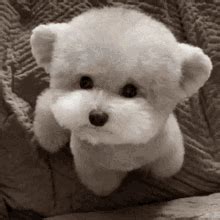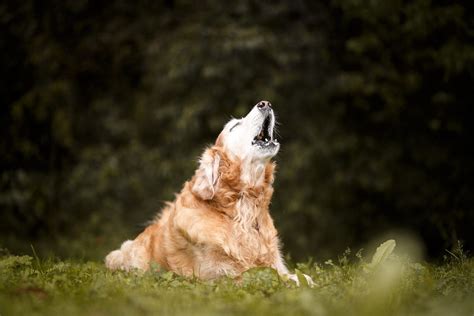
An impossibly fluffy puppy resembling a living teddy bear has captured hearts online, prompting widespread disbelief and adoration. Named Winnie, the puppy’s exceptionally plush fur and endearing features have drawn comparisons to a stuffed animal, sparking viral interest and debate about her authenticity.
Winnie, an English Goldendoodle, has become an internet sensation due to her striking resemblance to a plush toy. The adorable pup’s photos and videos, shared extensively across social media platforms, have garnered millions of views and comments, with many users expressing astonishment at her seemingly unreal appearance. Her owners, based in the United Kingdom, regularly post updates of Winnie’s daily life, further fueling the public’s fascination.
“People are just stopping in their tracks to admire her,” said Emily, Winnie’s owner. “She is quite a celebrity, and people are constantly commenting on how much she looks like a teddy bear.”
The breed, a cross between a Golden Retriever and a Poodle, is known for its intelligence, friendly temperament, and hypoallergenic coat, making it a popular choice for families. However, Winnie’s unique appearance sets her apart, even among Goldendoodles. Her exceptionally dense and evenly distributed fur, combined with her round face and button-like eyes, contributes to the overwhelming perception that she is more toy than pet.
Veterinarians suggest that Winnie’s exceptional coat could be attributed to a combination of genetic factors and careful grooming. While Goldendoodles are inherently fluffy, individual variations can result in remarkably plush coats like Winnie’s.
The internet’s reaction to Winnie has been overwhelmingly positive, with users expressing delight and amusement. Many have commented on her irresistible cuteness, while others have humorously questioned whether she is, in fact, a real dog. Some have even speculated about the level of grooming required to maintain her appearance, highlighting the dedication of her owners.
The phenomenon of Winnie underscores the enduring appeal of animals that possess human-like or toy-like qualities. In a world often filled with stress and uncertainty, the simple joy of seeing an adorable creature can provide a welcome respite, fostering a sense of connection and happiness.
Breed Background and Characteristics
The Goldendoodle, Winnie’s breed, has gained immense popularity over the past few decades. Originating in the 1990s, breeders aimed to combine the desirable traits of the Golden Retriever (known for its affectionate nature and trainability) with those of the Poodle (renowned for its intelligence and hypoallergenic coat). The result is a hybrid breed that is generally friendly, intelligent, and relatively low-shedding.
Goldendoodles come in various sizes, depending on the size of the Poodle parent used in the breeding process. Standard Goldendoodles are the largest, typically weighing between 50 and 90 pounds, while miniature and toy Goldendoodles are significantly smaller, ranging from 15 to 35 pounds. Their coats can vary in texture and color, from wavy and curly to straight, and from cream and gold to red and brown.
Despite their popularity, Goldendoodles are not recognized as a standardized breed by major kennel clubs like the American Kennel Club (AKC). This means that there is no official breed standard, leading to variability in appearance and temperament. Responsible breeders prioritize health testing and careful selection of breeding pairs to minimize the risk of genetic health problems.
The Appeal of Anthropomorphic Animals
Winnie’s widespread appeal can be attributed, in part, to the human tendency to anthropomorphize animals. Anthropomorphism is the attribution of human traits, emotions, or intentions to non-human entities, such as animals, objects, or natural phenomena. This tendency is deeply ingrained in human psychology and plays a significant role in how we interact with the world around us.
Throughout history, animals have been depicted as possessing human-like qualities in art, literature, and folklore. From Aesop’s fables to Disney cartoons, anthropomorphic animals have served as a powerful means of conveying moral lessons, exploring complex themes, and entertaining audiences of all ages.
The appeal of anthropomorphic animals stems from several factors. First, it allows us to connect with them on a deeper emotional level. By projecting human-like qualities onto animals, we can empathize with their experiences and understand their motivations. This can foster a sense of connection and compassion, leading to stronger bonds between humans and animals.
Second, anthropomorphism can make animals more relatable and understandable. By attributing human-like qualities to them, we can simplify their behavior and make it easier to predict their actions. This can be particularly helpful when interacting with animals, as it allows us to anticipate their needs and respond accordingly.
Third, anthropomorphism can be a source of humor and entertainment. The juxtaposition of human-like qualities with animal behavior can create amusing and often absurd situations, providing a welcome distraction from the stresses of daily life.
In the case of Winnie, her teddy bear-like appearance triggers a strong anthropomorphic response in many people. Her round face, button-like eyes, and plush fur evoke feelings of warmth, comfort, and nostalgia, making her seem more like a beloved toy than a living creature. This anthropomorphic projection enhances her appeal and contributes to her widespread popularity.
Grooming and Care Considerations
While Winnie’s adorable appearance is undoubtedly captivating, it’s essential to consider the grooming and care requirements associated with a Goldendoodle’s coat. Their fur can be prone to matting and tangling, especially if it’s long and dense. Regular brushing is crucial to prevent these issues and maintain a healthy, comfortable coat.
Professional grooming is often recommended every few months to keep the coat trimmed and tidy. Groomers can also provide specialized services such as de-shedding treatments and ear cleaning, which are essential for maintaining the overall health and hygiene of the dog.
In addition to grooming, Goldendoodles require regular exercise and mental stimulation. They are intelligent and energetic dogs that thrive on activity and interaction. Daily walks, playtime, and training sessions are essential for keeping them happy and healthy.
Potential owners should also be aware of the potential health problems that can affect Goldendoodles. These include hip dysplasia, elbow dysplasia, progressive retinal atrophy (PRA), and hypothyroidism. Responsible breeders conduct health testing on their breeding dogs to minimize the risk of these conditions.
The Psychology of Cuteness
The overwhelming response to Winnie highlights the power of “cuteness” in eliciting positive emotions and behaviors. Scientists have identified a set of features that are commonly associated with cuteness, including a round face, large eyes, a small nose, and soft features. These features are often found in infants and young animals, and they trigger a nurturing response in adults.
Konrad Lorenz, an Austrian ethologist, proposed the concept of “Kindchenschema,” or “baby schema,” to describe the set of infantile features that elicit caregiving behavior in adults. He argued that these features trigger an innate releasing mechanism that activates the parental instinct.
Studies have shown that viewing images of cute animals can activate the reward centers in the brain, releasing dopamine and other neurochemicals associated with pleasure and motivation. This can explain why people are drawn to cute animals and why they experience feelings of joy and happiness when interacting with them.
The cuteness of Winnie’s appearance likely plays a significant role in her widespread appeal. Her round face, large eyes, and plush fur trigger a strong nurturing response in viewers, making them feel compelled to protect and care for her.
Ethical Considerations of Hybrid Breeding
The popularity of Goldendoodles and other hybrid breeds has raised some ethical concerns. One concern is the lack of standardization within these breeds, which can lead to variability in appearance, temperament, and health. This can make it difficult for potential owners to know what to expect when adopting a hybrid dog.
Another concern is the potential for irresponsible breeding practices. The high demand for hybrid breeds can incentivize breeders to prioritize profit over the health and welfare of the animals. This can lead to the proliferation of puppy mills and other unethical breeding operations.
Potential owners of Goldendoodles and other hybrid breeds should carefully research breeders and choose those who prioritize health testing, responsible breeding practices, and the well-being of their dogs. It’s also essential to consider the potential health problems that can affect these breeds and to be prepared to provide the necessary care and attention.
Social Media and the Viral Phenomenon
Social media has played a crucial role in Winnie’s rise to fame. Platforms like Instagram, TikTok, and Facebook have allowed her owners to share photos and videos of her with a global audience. The ease with which content can be shared and disseminated on social media has contributed to the rapid spread of her image.
The viral nature of Winnie’s story highlights the power of social media to create and amplify cultural trends. In a world where information travels at lightning speed, a single image or video can quickly capture the attention of millions of people.
Social media has also allowed people to connect with Winnie on a more personal level. Through her owners’ posts, viewers can get a glimpse into her daily life and see her interacting with her family. This can foster a sense of connection and attachment, making her seem more like a friend than a distant celebrity.
The Enduring Appeal of Dogs
The story of Winnie underscores the enduring appeal of dogs as companion animals. For centuries, dogs have played a vital role in human societies, providing companionship, protection, and assistance in various tasks.
Dogs are known for their loyalty, affection, and unconditional love. They are often considered to be members of the family, providing emotional support and companionship to their owners. Studies have shown that owning a dog can have numerous health benefits, including reducing stress, lowering blood pressure, and increasing physical activity.
The bond between humans and dogs is a unique and powerful one. It is based on mutual respect, trust, and affection. Dogs offer us a sense of purpose and belonging, and they enrich our lives in countless ways.
Winnie’s story is a testament to the enduring appeal of dogs and the joy they bring to our lives. Her teddy bear-like appearance may be unusual, but her capacity for love and companionship is universal. She reminds us of the simple pleasures in life and the importance of cherishing the bonds we share with our animal companions.
Conclusion: A Fluffy Reminder of Joy
Winnie, the English Goldendoodle, has captured the internet’s attention not just for her striking resemblance to a teddy bear, but also as a fluffy ambassador of joy and connection. Her story, amplified by social media, underscores the human fascination with anthropomorphic animals and the enduring appeal of dogs as companions. Beyond the initial surprise and delight at her appearance, Winnie’s tale serves as a reminder of the simple pleasures found in the animal world and the profound bonds we share with our pets. From breed characteristics and grooming considerations to the psychology of cuteness and the ethics of hybrid breeding, Winnie’s viral fame opens a door to deeper conversations about our relationship with animals and the ways in which they enrich our lives. She is more than just a viral sensation; she is a symbol of the joy and connection that animals bring to our world.
Frequently Asked Questions (FAQ)
-
What breed is Winnie? Winnie is an English Goldendoodle, a cross between a Golden Retriever and a Poodle. This breed is known for its intelligence, friendly temperament, and relatively hypoallergenic coat.
-
Why does Winnie look like a teddy bear? Winnie’s teddy bear-like appearance is attributed to a combination of genetic factors and careful grooming. Her exceptionally dense and evenly distributed fur, along with her round face and button-like eyes, contribute to the illusion of a stuffed animal.
-
How much grooming does Winnie require? Goldendoodles like Winnie require regular grooming to prevent matting and tangling. Daily brushing is essential, and professional grooming is recommended every few months to keep the coat trimmed and tidy.
-
Are Goldendoodles hypoallergenic? Goldendoodles are often considered hypoallergenic because they shed less than many other breeds. However, no dog is truly 100% hypoallergenic. People with allergies should spend time with a Goldendoodle before adopting one to see if they have a reaction.
-
Where does Winnie live? Winnie lives in the United Kingdom with her owners, who regularly share updates of her daily life on social media.
-
Is Winnie a real dog or a stuffed animal? Winnie is a real dog, specifically an English Goldendoodle, although her incredibly plush fur and endearing features often lead people to question her authenticity.
-
What are some potential health problems that can affect Goldendoodles? Potential health problems include hip dysplasia, elbow dysplasia, progressive retinal atrophy (PRA), and hypothyroidism. Responsible breeders conduct health testing to minimize the risk of these conditions.
-
Why are Goldendoodles so popular? Goldendoodles are popular due to their friendly temperament, intelligence, relatively low-shedding coat, and suitability as family pets. They are also often sought after for their playful and affectionate nature.
-
How big do Goldendoodles get? Goldendoodles come in various sizes, depending on the size of the Poodle parent. Standard Goldendoodles typically weigh between 50 and 90 pounds, while miniature and toy Goldendoodles are smaller, ranging from 15 to 35 pounds.
-
Are Goldendoodles recognized by major kennel clubs like the AKC? No, Goldendoodles are not recognized as a standardized breed by major kennel clubs like the American Kennel Club (AKC). This means there is no official breed standard, leading to variability in appearance and temperament.
-
What is anthropomorphism, and how does it relate to Winnie’s popularity? Anthropomorphism is the attribution of human traits, emotions, or intentions to non-human entities. In Winnie’s case, her teddy bear-like appearance triggers a strong anthropomorphic response, making her seem more like a beloved toy and enhancing her appeal.
-
What is the “Kindchenschema” or “baby schema,” and how does it apply to Winnie? The “Kindchenschema” describes the set of infantile features (round face, large eyes, etc.) that elicit caregiving behavior. Winnie’s appearance triggers this response, making people feel compelled to protect and care for her.
-
What role has social media played in Winnie’s rise to fame? Social media platforms have allowed Winnie’s owners to share photos and videos with a global audience, leading to the rapid spread of her image and contributing to her viral fame.
-
What are some ethical considerations related to hybrid breeding, like Goldendoodles? Ethical concerns include the lack of standardization within breeds, the potential for irresponsible breeding practices driven by high demand, and the welfare of the animals. Responsible breeders prioritize health testing and ethical breeding practices.
-
What are the benefits of owning a dog, according to studies? Studies have shown that owning a dog can reduce stress, lower blood pressure, increase physical activity, and provide emotional support and companionship.
-
What is the best way to find a responsible Goldendoodle breeder? Look for breeders who prioritize health testing of their breeding dogs, provide a clean and enriching environment for their dogs, and are knowledgeable about the breed and willing to answer your questions thoroughly. Visit the breeder’s facilities, if possible, and ask for references from previous buyers.
-
How can I prevent matting in a Goldendoodle’s coat? Regular brushing, ideally daily, is crucial. Use a slicker brush and a metal comb to work through the coat, paying special attention to areas behind the ears, under the legs, and around the tail. Consider a professional grooming appointment every few months to keep the coat trimmed and maintained.
-
What are the typical personality traits of a Goldendoodle? Goldendoodles are generally friendly, intelligent, playful, and affectionate. They are typically good with children and other pets, making them suitable for families. They are also energetic and require regular exercise and mental stimulation.
-
How can I ensure my Goldendoodle gets enough exercise? Provide daily walks, playtime in a fenced yard, and interactive games such as fetch or tug-of-war. Consider enrolling in obedience classes or dog sports to provide mental stimulation and strengthen the bond with your dog.
-
What are some common grooming mistakes to avoid with a Goldendoodle? Avoid brushing only the top layer of the coat, which can lead to matting underneath. Don’t skip regular professional grooming appointments. Be careful when trimming the coat yourself to avoid accidentally cutting the skin. Don’t neglect ear cleaning, as Goldendoodles are prone to ear infections due to their floppy ears.









